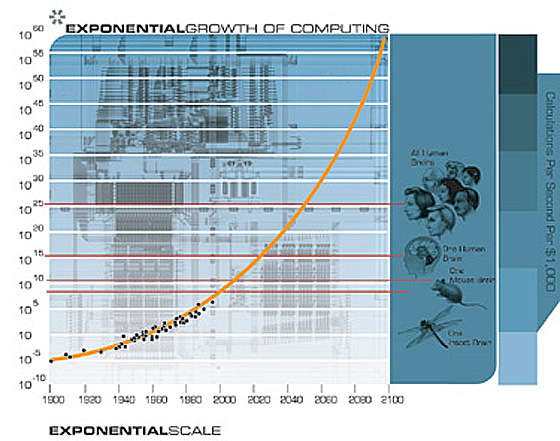Within thirty years, we will have the technological means to create superhuman intelligence. Shortly after, the human era will be ended.In part one I offered some thoughts on the first sentence of this quotation -- the time horizon for the development of superhuman intelligence. In this second part I will discuss the second sentence.
Vinge is wrong.
The human era has already ended.
And this points out an interesting fact about Singularities as a phenomenon. When you are in the midst of one, you can only see a little ahead and a little behind. So you don't really notice the gradual change underway. Only in hindsight can you look back and see that something fundamental changed at some point which made everything that came afterwards different.
Why do I say that the human era has already ended? Over the 40 years of my lifetime, humanity has developed a symbiotic relationship with computers -- a relationship which has now become a dependency. Over the 100 years before that we developed a dependency on industrialization and electricity, but this is fundamentally different. Imagine for a moment what would happen to our civilization if we were, for some reason, no longer able to use computers. Would the human race come to an end? No. Would hundreds of millions of people around the world perish? Almost certainly.
But leaving aside the obvious dependencies on computers for agriculture, transportation, safety and the like. And focus on one specific category of human endeavor, what economists like to call the "knowledge worker." The most productive category of our citizenry, the category that makes all of the advances in the rest of our society possible, is the knowledge worker. Scientist, engineer, designer, analyst, adviser... All of these people are dependent upon computers to do their jobs.
The next amazing medical breakthrough, the next computer chip, the next bridge or political campaign -- all of these things will be possible because a human being and a computer are working together. When you think about "superhuman intelligence" don't leave the human out of the equation. The very first superhuman intelligences are already here amongst us -- they are us, every time we use a computer to do something that, as a human, we couldn't have done on our own.
What is the most populous city on the planet? Mumbai, with over 13 million people. Am I so smart that I know this? No. Google told me about Wikipedia which has a page listing the most populous cities in the world.
Trying to understand Colony Collapse Disorder in which huge numbers of bees are dying? Scientists are using computerized DNA sequencing to uncover the reasons.
Designing a complex new product? You are probably using one of the many specialized Computer Aided Design software packages to make it possible.
Reading this post? Even if it is on paper, someone needed a computer to access it and print it out for you.
Our symbiotic relationship with computers has already made it possible for our generation to accomplish things that no previous human being could have done. We are already living in an age of "superhuman intelligence" -- one that will continue to accelerate as these computers continue to become more powerful and as they become more integrated into everything that we do.


